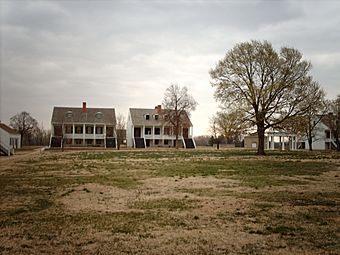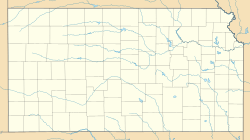Fort Scott National Historic Site facts for kids
|
Fort Scott National Historic Site
|
|
 |
|
| Location | Old Fort Blvd., Fort Scott, Kansas |
|---|---|
| Nearest city | Fort Scott, Kansas |
| Area | 17 acres (0.07 km2) |
| Built | 1842 |
| Architect | United States Army |
| Visitation | 24,654 (2024) |
| Website | Fort Scott National Historic Site |
| NRHP reference No. | 66000106 |
Quick facts for kids Significant dates |
|
| Added to NRHP | October 15, 1966 |
| Designated NHLD | July 19, 1964 |
| Designated NHS | October 19, 1978 |
Fort Scott National Historic Site is a special historical place in Bourbon County, Kansas. It's managed by the National Park Service and helps us remember an important time in American history.
This fort was named after General Winfield Scott, a famous military leader. In the mid-1800s, it was a key military base for the US Army. It stood on the edge of where people were settling in the West. For about 25 years, Fort Scott helped keep peace and supplied soldiers during big events. These included a time called Bleeding Kansas and the American Civil War.
Today, the site protects 20 old buildings, a large parade ground, and a restored area of tallgrass prairie. It's located right in the city of Fort Scott. You can visit most days of the year to learn about its past.
Contents
Fort Scott's Early History
Why the Fort Was Built
Fort Scott was built in 1842 on the American frontier. It was part of a military road connecting other forts like Fort Leavenworth and Fort Gibson. The main reason for building it was to protect the many settlers moving west from the Eastern United States.
The government also wanted to protect Native American tribes from these new settlers. Fort Scott was one of several forts meant to keep peace between everyone. The US government had planned to set aside land for Native Americans west of the Missouri River. However, more and more settlers kept moving onto these lands.
Fort Scott was busiest between 1842 and 1853. It was also used again during the Civil War.
Building the Fort
The Cherokee people in what is now Oklahoma were not happy about a nearby fort called Fort Wayne. So, the US Army decided to move its soldiers and build a new fort. This new fort would be between Fort Leavenworth and the old Fort Wayne site. The Army wanted to make the Cherokee happy and also protect settlers and other tribes from the Osage tribe, who sometimes raided the area.
On April 1, 1842, soldiers from Fort Wayne began their journey. They arrived at the future site of Fort Scott on April 22. After getting the land from the Cherokees, the rest of the soldiers arrived on May 30.
Unlike many forts, Fort Scott didn't have tall defensive walls when it was first built. The open land and new artillery technology made walls seem unnecessary. Soldiers focused on building places for people, animals, and equipment. These buildings were placed around a large parade ground.
Captain Thomas Swords was in charge of construction. Building on the Kansas prairie was tough because there weren't many trees. He had only a few skilled workers, and most soldiers had other duties. Wood was hard to get, and the sawmill was far away. Construction was slow, and accidents even destroyed some wood. By 1844, only one of the planned officers' houses was finished, and the soldiers' barracks were not complete. Still, an inspection in 1844 called Fort Scott "above average" compared to other frontier forts.
Life at the Fort
Life for the average soldier at Fort Scott was often boring. Before permanent buildings were ready, soldiers lived in uncomfortable tents. Few civilians lived at the fort, except for a few people selling goods. Some officers brought enslaved people with them to the fort.
The border with Missouri was only about 5 miles (8.2 km) east of Fort Scott. In Missouri, there was a shop where soldiers could buy drinks. Many soldiers would leave without permission to go there, leading to military trials. About 12 to 16% of soldiers left the fort without permission. This was due to boredom, not getting paid regularly, and disliking military life. Since there was no fighting near the fort, it felt more like a small frontier town than a military base. Hunting was a popular activity to pass the time.
By April 25, 1850, the US Army decided to stop building at Fort Scott. This was because of rising tensions that led to the Mexican–American War. The fort was still unfinished after eight years and a lot of money. Three years later, in 1853, the military left Fort Scott for good. They moved to Fort Riley, which was further west.
Fort Scott During Turbulent Times
Bleeding Kansas Conflict
Two years after the army left, the fort's buildings were sold to civilians. Some were turned into hotels. In 1854, a new law called the Kansas–Nebraska Act changed things. It allowed Kansas to decide if it would permit slavery, which went against an older law.
People from Missouri who supported slavery moved to Kansas to try and influence the vote. At the same time, settlers from New England arrived, determined to keep slavery out. These two groups fought fiercely in what became known as "Bleeding Kansas."
At Fort Scott, each side claimed one of the old fort hotels. The "Free-Soil" group, who opposed slavery, used the Fort Scott Hotel. The "Pro-Slavery" group used the Western Hotel. Most people in Fort Scott supported slavery, but those outside the town often opposed it. During this time, there were local fights, murders, and attempts to burn buildings.
The Civil War and Beyond
When the American Civil War began, the fort became a military post again. In August 1861, the Union Army took control of Fort Scott. They prepared it for wartime use. The Army rented several blocks in the town for supplies and equipment. Soldiers from many states, including Indiana, Iowa, and Ohio, came to the fort. They either stayed there or traveled to fight in Missouri, Arkansas, or the Indian Territory. Fort Scott was also one of the places that recruited and trained African American soldiers for the United States Colored Troops.
The fort became a major supply center. Confederate General Sterling Price hoped to capture the town, but his forces never got closer than 10 miles (16 km) away. Fort Scott was important because it was in an area with Southern sympathizers. It was also close to the Confederate state of Arkansas and the "unstable" Indian Territory, where many Native American tribes sided with the Confederates. The fort also served as a large military hospital and a prison during the war.
After the war ended, in October 1865, the US Army left the fort again. They sold off what they owned.
On January 14, 1870, the Army returned to the area, forming the "Post of Southeast Kansas." The soldiers camped near the railroad tracks and rarely used the original fort buildings. Their job was to protect the railroads and their workers from settlers. Some settlers feared the railroad companies would take their land. They saw the soldiers as working for the railroads and considered both as enemies.
Settlers also had ongoing conflicts with Native Americans and outlaws. By the spring of 1873, the US Army left Fort Scott for good. From 1873 until 1965, the fort's buildings were left empty and slowly fell apart. Many military buildings were torn down and replaced with civilian structures.
Fort Scott Today
Thanks to a law passed on August 31, 1965, the National Park Service gave the city of Fort Scott money and help to restore the fort.
On October 19, 1978, Fort Scott officially became a National Historic Site. It covers 17 acres (0.07 km2) and is managed by the National Park Service. Today, you can visit the fort almost any day of the year. It's only closed on Thanksgiving, Christmas, and New Year's Day.
The site still has many original buildings. These include four officers' barracks, two infantry barracks, a hospital, a guardhouse, stables, and a bake shop. There's also a flagpole and a magazine (where ammunition was stored). Another cool part of the park is 5 acres (20,000 m2) of restored tallgrass prairie. This project helps bring back the natural environment of the area.
See also




